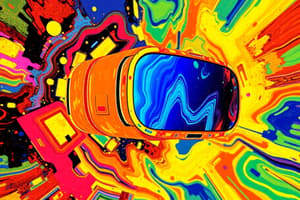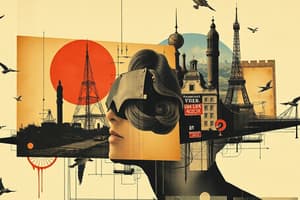Podcast
Questions and Answers
What is the main difference between augmented reality (AR) and mixed reality (MR)?
What is the main difference between augmented reality (AR) and mixed reality (MR)?
- AR is used for entertainment, while MR is used for education and business
- AR is a computer-simulated experience, while MR is a camera live feed
- AR blends digital content with the real world, while MR merges the real world and virtual worlds (correct)
- AR and MR are the same thing
What is the name of the tracking technology used by HTC Vive?
What is the name of the tracking technology used by HTC Vive?
- Oculus Rift
- Lighthouse (correct)
- Project Morpheus
- SteamSight
What is the name of the standalone headset released by Oculus in 2019?
What is the name of the standalone headset released by Oculus in 2019?
- HTC Vive
- Oculus Quest 2 (correct)
- Oculus Rift S
- Project Morpheus
What is the name of the industry standards organization for web-based 3D graphics?
What is the name of the industry standards organization for web-based 3D graphics?
What are the most prevalent short-term adverse effects of using VR headsets?
What are the most prevalent short-term adverse effects of using VR headsets?
What is the name of the ecosystem that incorporates the many diverse applications of virtual reality?
What is the name of the ecosystem that incorporates the many diverse applications of virtual reality?
What is the name of the first Virtual Reality based Flight Simulation Training Device approved by EASA in 2021?
What is the name of the first Virtual Reality based Flight Simulation Training Device approved by EASA in 2021?
What is the main advantage of VR technology in education?
What is the main advantage of VR technology in education?
What is virtual reality sickness?
What is virtual reality sickness?
Flashcards are hidden until you start studying
Study Notes
Virtual Reality: A Comprehensive Overview
-
Virtual reality (VR) is a computer-simulated experience that uses pose tracking and 3D near-eye displays to give the user an immersive feel of a virtual world.
-
VR is used in entertainment, education, and business, and it includes applications like video games, medical and military training, and virtual meetings.
-
Standard VR systems use virtual reality headsets or multi-projected environments to generate realistic images, sounds, and other sensations that simulate a user's physical presence in a virtual environment.
-
The term "virtual reality" was first used in a science fiction context in 1982, and it was popularized by Jaron Lanier in the late 1980s.
-
Other types of VR-style technology include augmented reality (AR) and mixed reality (MR), which blend digital content with the real world.
-
VR can be realized through simulation-based VR, avatar image-based VR, projector-based VR, desktop-based VR, and head-mounted displays (HMDs).
-
HMDs include two small high-resolution OLED or LCD monitors, a binaural audio system, positional and rotational real-time head tracking for six degrees of movement, and motion controls with haptic feedback for physical interaction within the virtual world.
-
AR systems layer virtual information over a camera live feed into a headset or smartglasses or through a mobile device.
-
MR merges the real world and virtual worlds to produce new environments and visualizations where physical and digital objects co-exist and interact in real-time.
-
The first references to virtual reality came from science fiction, but the development of perspective in Renaissance European art and the stereoscope invented by Sir Charles Wheatstone were both precursors to VR.
-
The VR industry mainly provided VR devices for medical, flight simulation, automobile industry design, and military training purposes from 1970 to 1990.
-
The 2000s were a period of relative public and investment indifference to commercially available VR technologies, but in 2010, Palmer Luckey designed the first prototype of the Oculus Rift.A Brief History and Overview of Virtual Reality
-
Valve showed off their SteamSight prototype in early 2014, which shared major features with the consumer headsets including separate 1K displays per eye, low persistence, positional tracking over a large area, and fresnel lenses.
-
In 2015, HTC and Valve announced the virtual reality headset HTC Vive and controllers, which included tracking technology called Lighthouse, utilizing wall-mounted "base stations" for positional tracking using infrared light.
-
Sony announced Project Morpheus (its code name for the PlayStation VR) in 2014 and in 2016, HTC shipped its first units of the HTC Vive SteamVR headset.
-
In 2019, Oculus released the Oculus Rift S and a standalone headset, the Oculus Quest, utilizing inside-out tracking compared to external outside-in tracking seen in previous generations of headsets.
-
In 2020, Oculus released the Oculus Quest 2, with new features including a sharper screen, reduced price, and increased performance.
-
In 2021, EASA approved the first Virtual Reality based Flight Simulation Training Device.
-
Virtual Reality Modelling Language (VRML) was first introduced in 1994, and the Web3D consortium was subsequently founded in 1997 for the development of industry standards for web-based 3D graphics.
-
Modern virtual reality headset displays are based on technology developed for smartphones including gyroscopes and motion sensors for tracking head, body, and hand positions, small HD screens for stereoscopic displays, and small, lightweight and fast computer processors.
-
Virtual reality is most commonly used in entertainment applications such as video games, 3D cinema, amusement park rides, and social virtual worlds.
-
In social sciences and psychology, virtual reality offers a cost-effective tool to study and replicate interactions in a controlled environment and can be used as a form of therapeutic intervention.
-
VR can simulate real workspaces for workplace occupational safety and health purposes, educational purposes, and training purposes.
-
Virtual reality's growing market presents an opportunity and an alternative channel for digital marketing.
-
Virtual reality technology has demonstrated being capable of promoting higher-order thinking, promoting the interest and commitment of students, the acquisition of knowledge, promoting mental habits, and understanding that are generally useful within an academic context.Virtual Reality: Applications, Concerts, Concerns and Challenges
Applications of Virtual Reality:
- Virtual reality technology has been used for gaming and entertainment purposes.
- Virtual reality has been used in medical applications, such as therapy for post-traumatic stress disorder (PTSD).
- Virtual reality has also been used in architectural and engineering applications.
- Virtual reality can be used in archeological digs and recreations of famous landmarks.
- Virtual reality can support people's grieving process through digital recreations of deceased individuals.
- Growing interest in the metaverse has resulted in organizational efforts to incorporate the many diverse applications of virtual reality into ecosystems like VIVERSE.
Concerts in Virtual Reality:
- Many musicians have performed virtual reality concerts, including Jean Michel Jarre, Justin Bieber, Non-Player Character, Foo Fighters, Post Malone, Megan Thee Stallion, Billie Eilish, and Imagine Dragons.
Concerns and Challenges of Virtual Reality:
- Virtual reality has many health and safety considerations, with some users experiencing twitches, seizures, or blackouts while using VR headsets.
- Motion sickness, eyestrain, headaches, and discomfort are the most prevalent short-term adverse effects.
- Virtual reality sickness can occur when a person's exposure to a virtual environment causes symptoms similar to motion sickness symptoms.
- Children may respond cognitively and behaviorally to immersive VR in ways that differ from adults.
- VR systems make the technology particularly useful for, and vulnerable to, mass surveillance.
- Data from eye tracking sensors may indirectly reveal information about a user's ethnicity, personality traits, fears, emotions, interests, skills, and physical and mental health conditions.
Studying That Suits You
Use AI to generate personalized quizzes and flashcards to suit your learning preferences.



